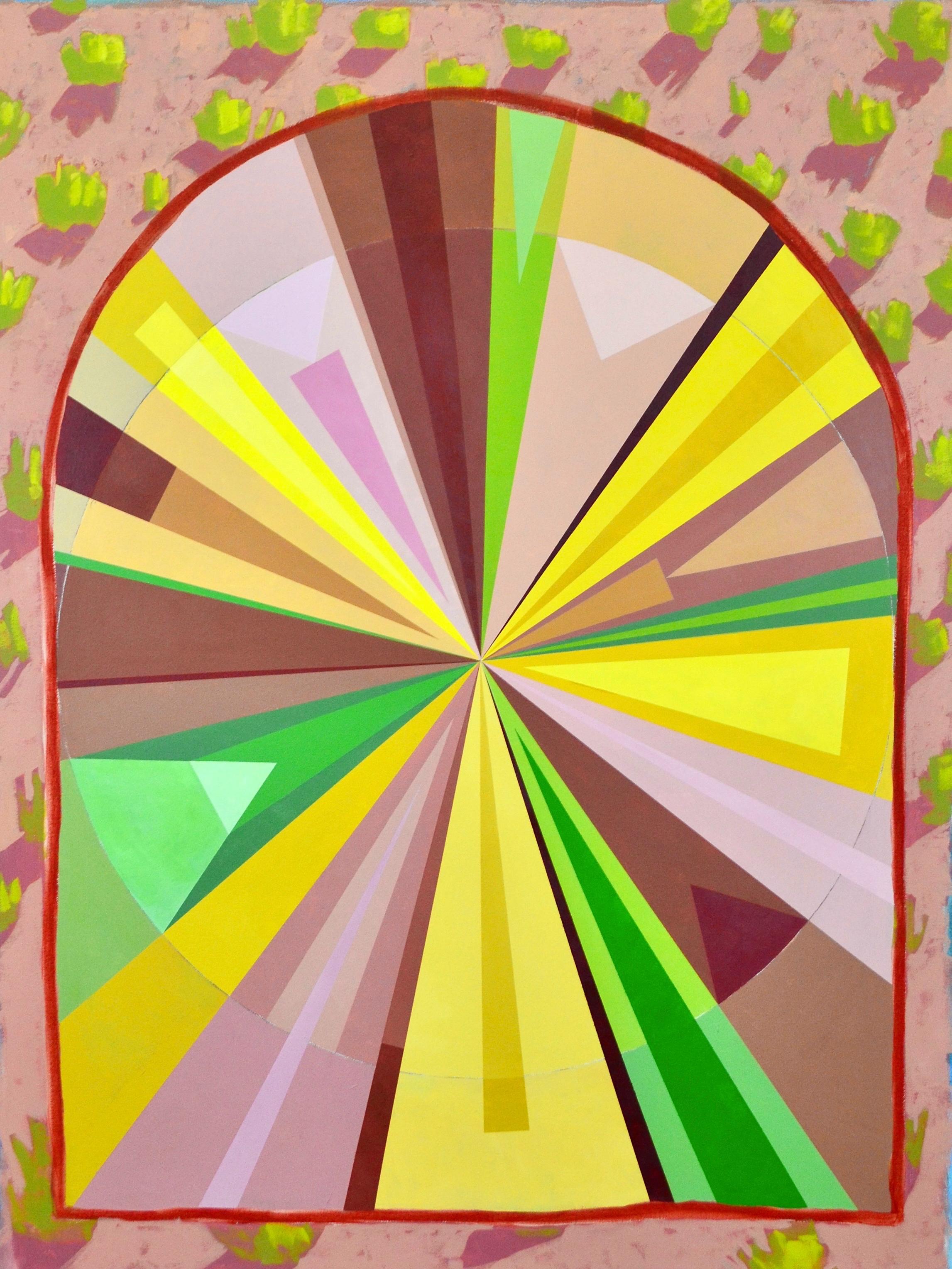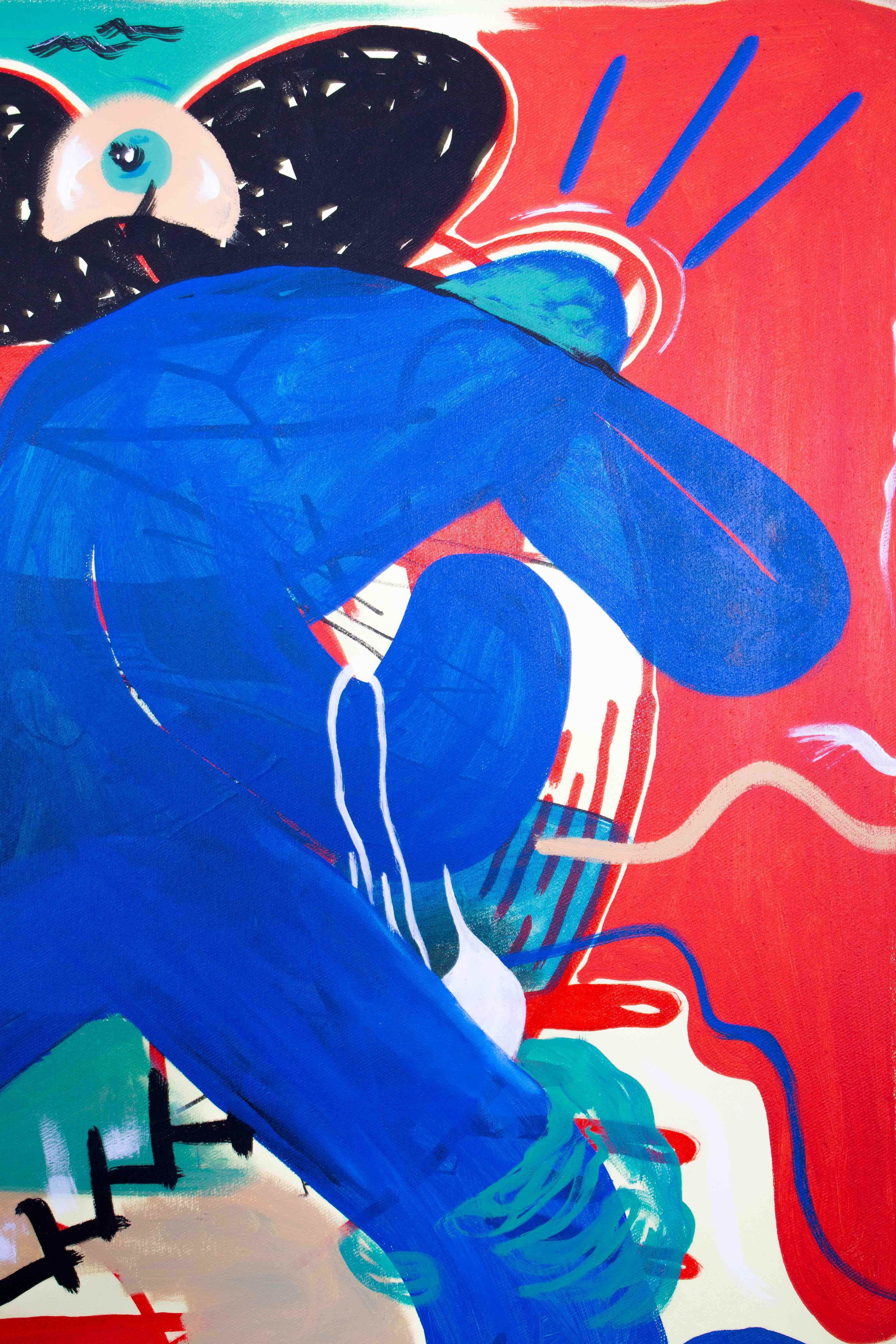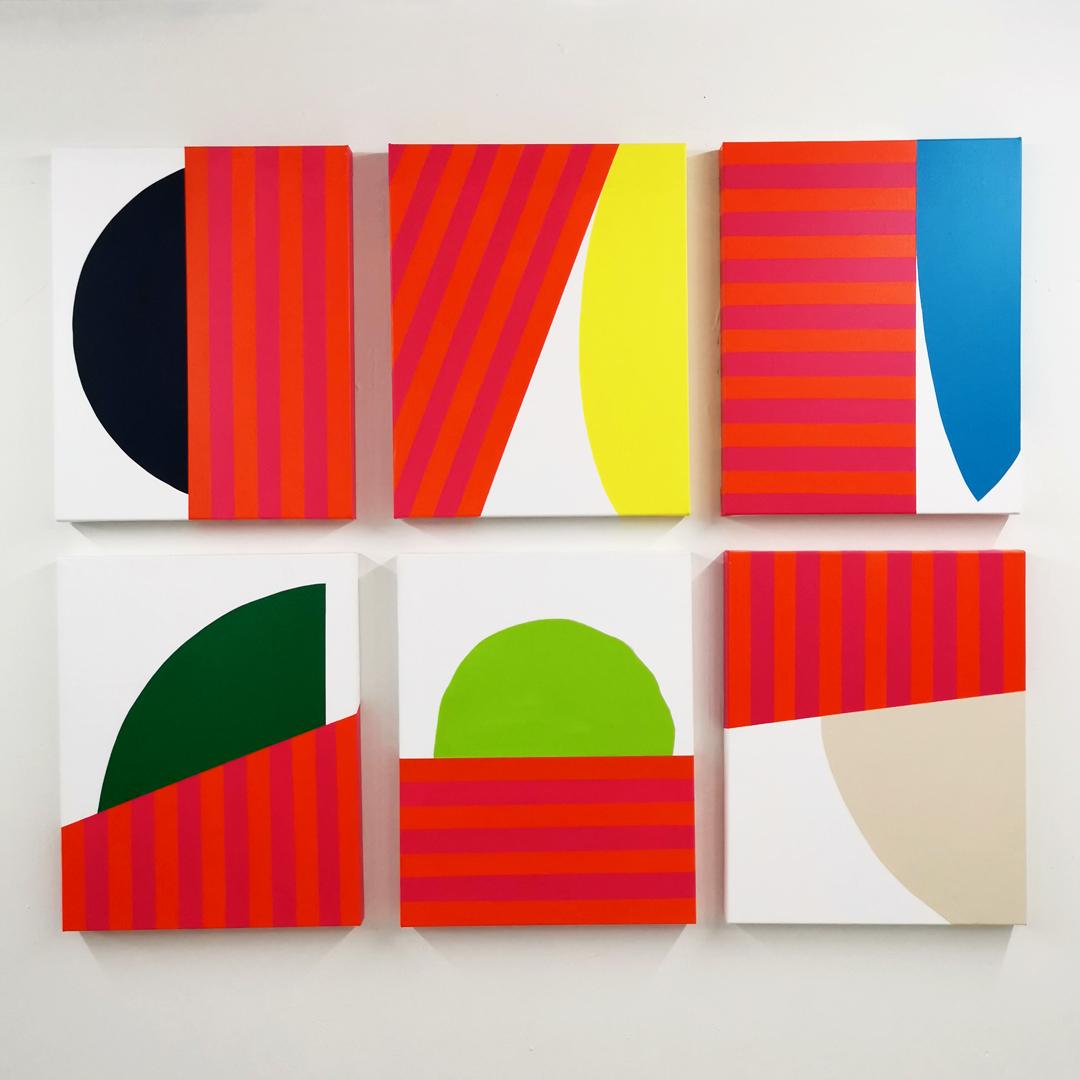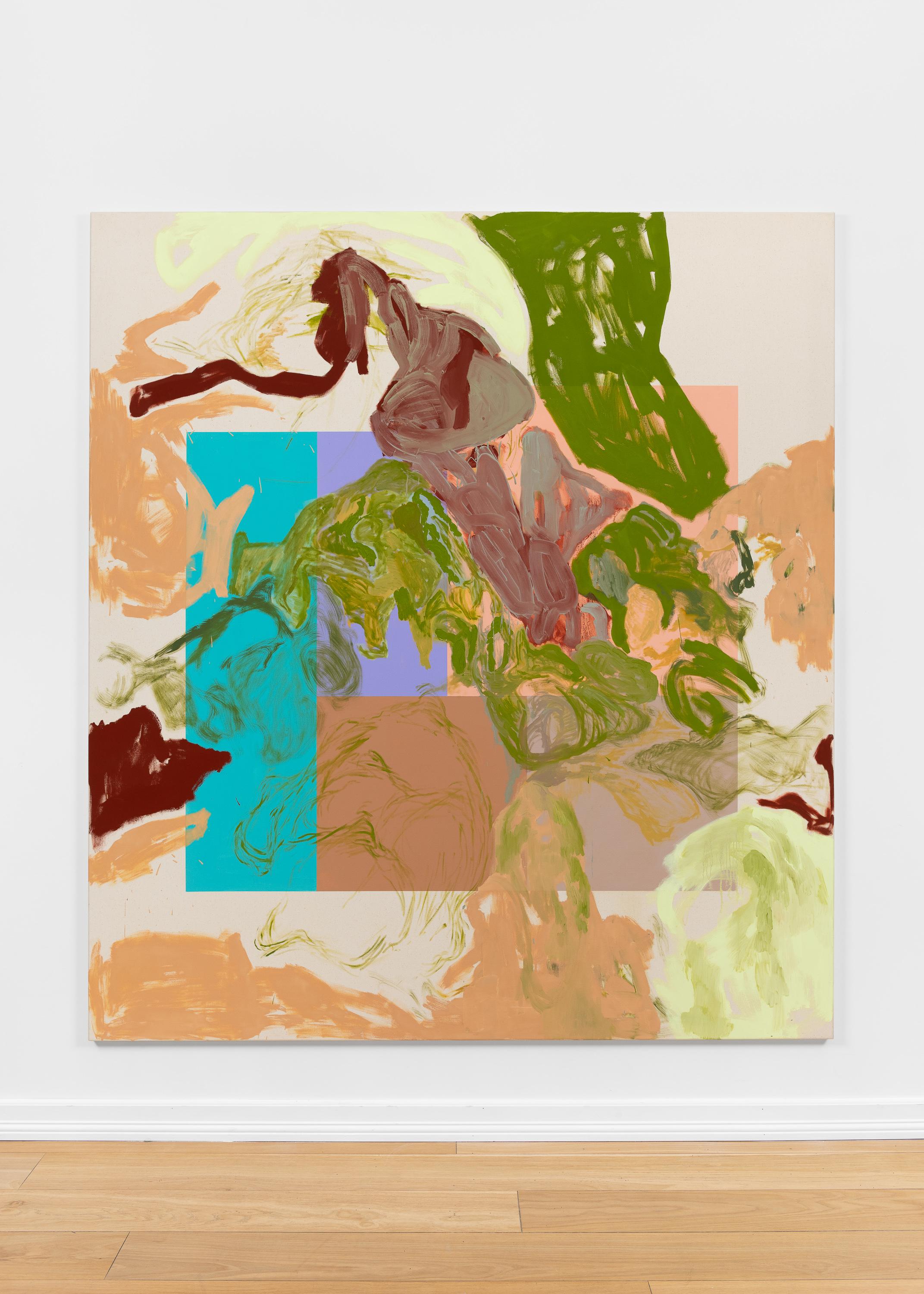Items Similar to “My Word against Theirs”
Want more images or videos?
Request additional images or videos from the seller
1 of 13
Joseph Conrad-Ferm“My Word against Theirs”2011
2011
About the Item
Original acrylic on canvas painting by Cape Cod, Massachusetts artist, Joseph Conrad Ferm. Signed lower right. Titled, dated and signed verso. Executed in 2011. Condition is excellent.
The painting is framed in a contemporary black wood shadow box frame. Overall measurements are 49.5 by 37.5 inches. Provenance: A Southampton, New York gentleman.
Joseph Conrad-Ferm
Joseph Conrad-Ferm is a self taught painter who did not discover his need to paint until age 26. With over 1,000 finished works on paper, canvas, and wood, Ferm's paintings are in public and private collections worldwide. His work is extensively used by interior designers and has been featured in design publications in the US. He currently resides in Cape Cod, MA.
- Creator:
- Creation Year:2011
- Dimensions:Height: 48 in (121.92 cm)Width: 36 in (91.44 cm)Depth: 2.5 in (6.35 cm)
- Medium:
- Movement & Style:
- Period:
- Condition:
- Gallery Location:Southampton, NY
- Reference Number:1stDibs: LU14113448422
About the Seller
4.9
Platinum Seller
These expertly vetted sellers are 1stDibs' most experienced sellers and are rated highest by our customers.
Established in 1977
1stDibs seller since 2013
465 sales on 1stDibs
Typical response time: 1 hour
- ShippingRetrieving quote...Ships From: Southampton, NY
- Return PolicyA return for this item may be initiated within 7 days of delivery.
More From This SellerView All
- “Art Focus”By Joseph Conrad-FermLocated in Southampton, NYOriginal acrylic paint on canvas by the American artist, Joseph Conrad-Ferm. Signed lower right. Signed, titled and dated verso, 2015. Condition is excellent. Presently unframed. P...Category
2010s Contemporary Abstract Paintings
MaterialsAcrylic, Canvas
- “Untitled”Located in Southampton, NYHighly textured acrylic on canvas painting by Susan Wilmarth. Signed verso and dated 1981. Untitled. Condition is excellent. Unframed. Provenance: A Long Island, New York collector. Susan Wilmarth was born in 1942 and is known for her abstract paintings. She exhibited at MoMA in 1972 and her paintings are in many private collections. She was the wife of Christopher Wilmarth...Category
1880s Contemporary Abstract Paintings
MaterialsCanvas, Acrylic
- “Gulfside”By Syd SolomonLocated in Southampton, NYOriginal, oil paint and acrylic paint on canvas by the well known American artist, Syd Solomon. Signed bottom middle by the artist. Titled and dated verso 1983. Condition is excellent. Original gallery floating frame. Overall framed measurements are 38 by 42 inches. Provenance: A Sarasota, Florida collector. SYD SOLOMON BIOGRAPHY Written by Dr. Lisa Peters/Berry Campbell Gallery “Here, in simple English, is what Syd Solomon does: He meditates. He connects his hand and paintbrush to the deeper, quieter, more mysterious parts of his mind- and he paints pictures of what he sees and feels down there.” --Kurt Vonnegut Jr. from Palm Sunday, 1981 Syd Solomon was born near Uniontown, Pennsylvania, in 1917. He began painting in high school in Wilkes-Barre, where he was also a star football player. After high school, he worked in advertising and took classes at the Art Institute of Chicago. Before the attack on Pearl Harbor, he joined the war effort and was assigned to the First Camouflage Battalion, the 924th Engineer Aviation Regiment of the US Army. He used his artistic skills to create camouflage instruction manuals utilized throughout the Army. He married Ann Francine Cohen in late 1941. Soon thereafter, in early 1942, the couple moved to Fort Ord in California where he was sent to camouflage the coast to protect it from possible aerial bombings. Sent overseas in 1943, Solomon did aerial reconnaissance over Holland. Solomon was sent to Normandy early in the invasion where his camouflage designs provided protective concealment for the transport of supplies for men who had broken through the enemy line. Solomon was considered one of the best camoufleurs in the Army, receiving among other commendations, five bronze stars. Solomon often remarked that his camouflage experience during World War II influenced his ideas about abstract art. At the end of the War, he attended the École des Beaux-Arts in Paris. Because Solomon suffered frostbite during the Battle of the Bulge, he could not live in cold climates, so he and Annie chose to settle in Sarasota, Florida, after the War. Sarasota was home to the John and Mable Ringling Museum of Art, and soon Solomon became friends with Arthur Everett “Chick” Austin, Jr., the museum’s first Director. In the late 1940s, Solomon experimented with new synthetic media, the precursors to acrylic paints provided to him by chemist Guy Pascal, who was developing them. Victor D’Amico, the first Director of Education for the Museum of Modern Art, recognized Solomon as the first artist to use acrylic paint. His early experimentation with this medium as well as other media put him at the forefront of technical innovations in his generation. He was also one of the first artists to use aerosol sprays and combined them with resists, an innovation influenced by his camouflage experience. Solomon’s work began to be acknowledged nationally in 1952. He was included in American Watercolors, Drawings and Prints at the Metropolitan Museum of Art, New York. From 1952–1962, Solomon’s work was discovered by the cognoscenti of the art world, including the Museum of Modern Art Curators, Dorothy C. Miller and Peter Selz, and the Whitney Museum of American Art’s Director, John I. H. Baur. He had his first solo show in New York at the Associated American Artists Gallery in 1955 with “Chick” Austin, Jr. writing the essay for the exhibition. In the summer of 1955, the Solomons visited East Hampton, New York, for the first time at the invitation of fellow artist David Budd...Category
1980s Abstract Expressionist Abstract Paintings
MaterialsCanvas, Oil, Acrylic
- “Lightride”By Syd SolomonLocated in Southampton, NYHere for your consideration is a great example of the artwork of the well known American artist, Syd Solomon. Signed top left. Titled and dated verso 1978. The painting is oil and acrylic paint on mounted synthetic canvas. Condition is excellent. Overall framed measurements are 44.75 by 24.5 inches. Provenance: A Sarasota, Florida collector. SYD SOLOMON BIOGRAPHY American 1917-2004 Written by Dr. Lisa Peters/Berry Campbell Gallery “Here, in simple English, is what Syd Solomon does: He meditates. He connects his hand and paintbrush to the deeper, quieter, more mysterious parts of his mind- and he paints pictures of what he sees and feels down there.” --Kurt Vonnegut Jr. from Palm Sunday, 1981 Syd Solomon was born near Uniontown, Pennsylvania, in 1917. He began painting in high school in Wilkes-Barre, where he was also a star football player. After high school, he worked in advertising and took classes at the Art Institute of Chicago. Before the attack on Pearl Harbor, he joined the war effort and was assigned to the First Camouflage Battalion, the 924th Engineer Aviation Regiment of the US Army. He used his artistic skills to create camouflage instruction manuals utilized throughout the Army. He married Ann Francine Cohen in late 1941. Soon thereafter, in early 1942, the couple moved to Fort Ord in California where he was sent to camouflage the coast to protect it from possible aerial bombings. Sent overseas in 1943, Solomon did aerial reconnaissance over Holland. Solomon was sent to Normandy early in the invasion where his camouflage designs provided protective concealment for the transport of supplies for men who had broken through the enemy line. Solomon was considered one of the best camoufleurs in the Army, receiving among other commendations, five bronze stars. Solomon often remarked that his camouflage experience during World War II influenced his ideas about abstract art. At the end of the War, he attended the École des Beaux-Arts in Paris. Because Solomon suffered frostbite during the Battle of the Bulge, he could not live in cold climates, so he and Annie chose to settle in Sarasota, Florida, after the War. Sarasota was home to the John and Mable Ringling Museum of Art, and soon Solomon became friends with Arthur Everett “Chick” Austin, Jr., the museum’s first Director. In the late 1940s, Solomon experimented with new synthetic media, the precursors to acrylic paints provided to him by chemist Guy Pascal, who was developing them. Victor D’Amico, the first Director of Education for the Museum of Modern Art, recognized Solomon as the first artist to use acrylic paint. His early experimentation with this medium as well as other media put him at the forefront of technical innovations in his generation. He was also one of the first artists to use aerosol sprays and combined them with resists, an innovation influenced by his camouflage experience. Solomon’s work began to be acknowledged nationally in 1952. He was included in American Watercolors, Drawings and Prints at the Metropolitan Museum of Art, New York. From 1952–1962, Solomon’s work was discovered by the cognoscenti of the art world, including the Museum of Modern Art Curators, Dorothy C. Miller and Peter Selz, and the Whitney Museum of American Art’s Director, John I. H. Baur. He had his first solo show in New York at the Associated American Artists Gallery in 1955 with “Chick” Austin, Jr. writing the essay for the exhibition. In the summer of 1955, the Solomons visited East Hampton, New York, for the first time at the invitation of fellow artist David Budd...Category
1970s Abstract Expressionist Abstract Paintings
MaterialsCanvas, Oil, Acrylic, Board
- “Woman with Birds”By Nahum TschacbasovLocated in Southampton, NYOriginal post modern acrylic on canvas painting of a woman with birds and a large bouquet of flowers by the well known Russian/American artist Nahum Ts...Category
1980s Post-Modern Abstract Paintings
MaterialsCanvas, Acrylic
- “Oranges”Located in Southampton, NYInteresting abstract of a stillife of oranges by the American artist, Clifford Johnson. Signed lower left. Titled verso. Condition is excellent. Circa 1970. Presently unframed. ...Category
1970s Contemporary Abstract Paintings
MaterialsCanvas, Oil
You May Also Like
- American, Contemporary, Abstract, Circular and Colorfully Large WorkLocated in Fort Worth, TXLayla Luna, Ramona II, 2020, Acrylic on canvas. 48 x 36." This fantastical painting by American artist Layla Luna is a contemporary, abstract, circular, and...Category
21st Century and Contemporary Contemporary Abstract Paintings
MaterialsCanvas, Oil, Acrylic
- «Taking a chance on the dancefloor» Acrylic on Canvas by O. F. HvidstenBy Ole Fredrik HvidstenLocated in Oslo, NOSigned and dated. «Taking a chance on the dancefloor» was part of O. F. Hvidsten's first solo-exhibition «This will never pass». The works comprising the exhibition is first and fo...Category
2010s Contemporary Figurative Paintings
MaterialsCanvas, Acrylic
- «Covers» Abstract Acrylic paint on Canvas, six equal parts by Dustin Cook, 2021By Dustin CookLocated in Oslo, NOInspired by the crossroads of human nature and human technology, Dustin Cook makes abstraction look funny. At the core, his work represents playfulness, hi...Category
2010s Contemporary Abstract Paintings
MaterialsCanvas, Acrylic
- «Me and my girl» Acrylic on Canvas by O. F. HvidstenBy Ole Fredrik HvidstenLocated in Oslo, NOSigned and dated. «Me and my girl» was part of O. F. Hvidsten's first solo-exhibition «This will never pass». The works comprising the exhibition is first and foremost a visual mem...Category
2010s Contemporary Figurative Paintings
MaterialsCanvas, Acrylic
- SnittLocated in Oslo, 03Acrylic and oil on canvasCategory
2010s Contemporary Abstract Paintings
MaterialsCanvas, Oil, Acrylic
- PlakatLocated in Oslo, 03Acrylic and oil on canvasCategory
2010s Contemporary Abstract Paintings
MaterialsCanvas, Oil, Acrylic
Recently Viewed
View AllMore Ways To Browse
Butlers Helper
Italy Fl Jewelry
Phillips Gallery Utah
John Hampton Bronze
Mother Of Pearl Light Shade
Antique Hindu Table Dinner
Jane Whitehurst Art
Western Photography Guild
San Francisco San Francisco Paintings
Signed Canvas
Painting Woods
Jim Work
David Nance
Oil Painting Roses On Table
Cathedral Interior Oil
Lynn Fur
Mear One
Irene Pattinson On Sale





